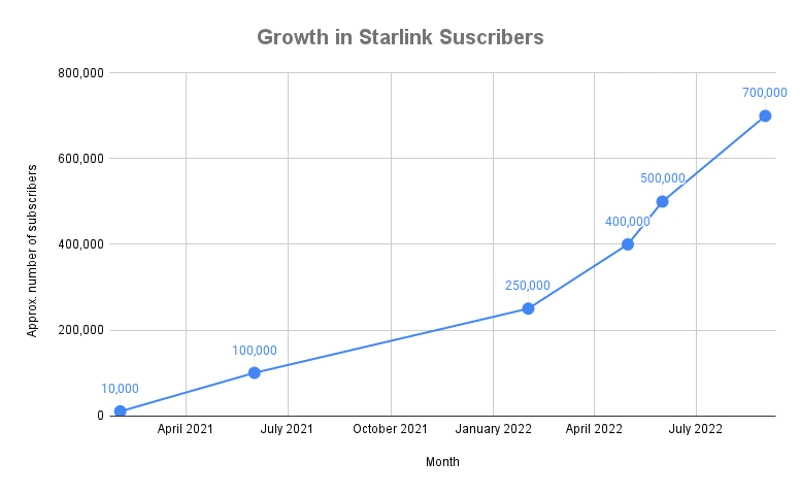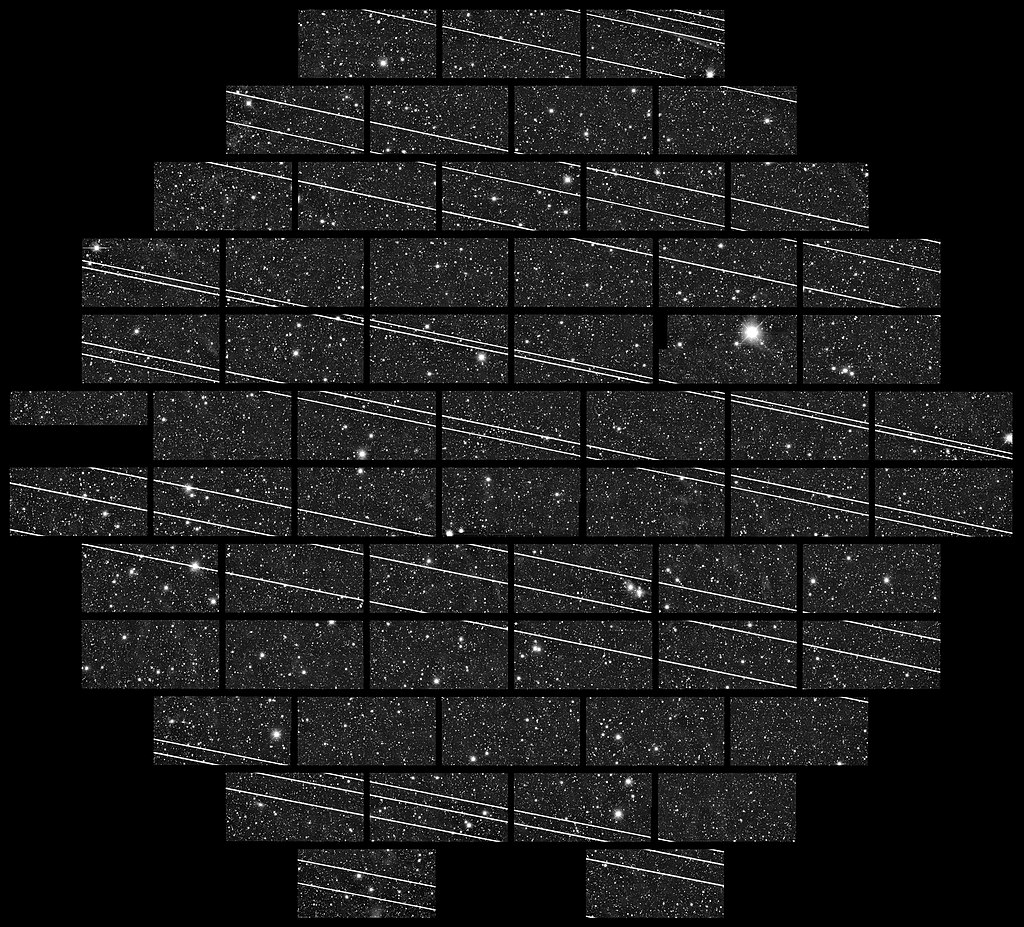Starlink: The future of internet connectivity
The internet has seen many improvements since it became ubiquitous in the 2000s, both in terms of speed and accessibility.
But despite seeming like everyone in the world is connected and taking part in social media, “around half of the world is not yet online” – Ourworldindata.org
However, Elon Musk is on a mission to change this. Starlink is looking to provide fast internet connections to even the most remote locations, and it looks like it is already here.
In this guide, we give you a brief run-down of Starlink, including a summary of what existing users think about their new satellite connection.
Contents
- What is Starlink?
- How did Starlink originate?
- How fast is Starlink growing?
- How fast and reliable is Starlink in reality?
- How expensive is Starlink in the UK?
- How easy is Starlink to set up?
- Does Starlink have competition?
- Are there any issues with Starlink?
What is Starlink?
Starlink is a satellite internet constellation (i.e. a network of satellites that enable wireless internet connectivity under its area of influence) that currently operates in 40 countries, including its 200-mile offshore jurisdiction.
Service is currently available for homes, businesses, Recreational Vehicles (RVs), marine vessels and commercial aeroplanes. Connecting only requires the installation of Starlink’s own mass-produced satellite dishes within coverage areas.
This ease-of-use unlocks internet connectivity to historically disserved remote areas, improves reliability within areas already covered by traditional broadband internet, and enables reliable internet to previously unthinkable places like the cruising altitude of aeroplanes.
The network comprises 3,177 satellites orbiting the Earth in a Low-Earth Orbit. These communicate with each other via optical lasers while providing internet connectivity to the underlying regions of Earth and its atmosphere over the K-frequency bands.
Starlink is operated by Elon Musk’s Space X, which manufactures and launches the satellites from its own facilities in the US.
How did Starlink originate?
Starlink was publicly announced in 2015 at the same time SpaceX opened its satellite development facility in the US. Its origins, however stem from another project called WorldVu, where Elon Musk was also working together with a team to launch a satellite internet constellation.
WorldVu then stemmed into two different now competing companies one of them being Starlink by SpaceX.
Over the years, Starlink has had to overcome multiple technical and regulatory challenges, including improvements to satellites as well as having clear space debris mitigation plans.
SpaceX started launching Starlink satellites as early as 2018 and opened their beta internet service in late 2020.
How fast is Starlink growing?
As of December 2023, Starlink has produced 5,605 satellites, of which 5,226 are currently in orbit, and 2,646 are operational (i.e. providing satellite internet). You can see a map with the current locations of all Starlink satellites here.
In terms of subscriber growth, Starlink has now reached approximately 700,000 subscribers globally, as per the graph below.

This comes as no surprise, given how simple the installation is for individuals in regions where the Starlink network is already available.
The mainland areas being covered by Starlink’s satellite internet are expected to duplicated by the end of 2023, and global maritime coverage for industrial, commercial and private marine applications is also expected by next year.
What we found surprising was that coverage limitations were predominantly due to red tape from the telecom regulators of each country, as the current network can actually cover the entire world at latitudes below 60 degrees (i.e. as North as the northern tip of Scotland or as South as a couple of hundred miles off the coast of Tasmania).
The International Telecommunication Union (ITU) is the UN agency that deals with telecoms, and it dictates that each country’s own regulators must approve any satellite telecoms before they’re allowed to operate, as it may affect existing Telecomms or even become a national security threat.
How fast and reliable is Starlink in reality?
Hundreds of Youtubers from all around the world have been live-testing Starlink, showing what the real user experience is on the ground.
This YouTuber in Mexico describes Starlink’s connection to his house as being “significantly more reliable” than his local broadband connection, even when testing Starlink during a hailstorm.
Another Youtuber from a remote area of Michigan in the US was pleased with his connection overall, experiencing some slower speeds during snowy conditions while highly rating Starlink’s customer services despite occasionally losing connection.
He doesn’t think Starlink is there to “replace ultra-fast broadband” but to provide internet to areas that were currently disserved, like his own home.
This gamer who famously lives and games from an RV (and was doing so with a mobile LTE connection) recently tested Starlink in the remote mountains of Colorado in the US and had enough speed and latency to play games like Overwatch reliably- a big improvement on his previous connection.
Finally, this person in rural North Wales who has been long awaiting fibre optic described getting download speeds almost on par with fibre optics from Starlink.
These are the Starlink internet speeds reported from the limited testing done by these users:
| Location | Reported download speeds (Very limited testing) |
|---|---|
| Mexico | 100-250 Mbps |
| Michigan, US | 30-250 |
| Colorado, US | 70-160 |
| North Wales | 150-250 |
How expensive is Starlink in the UK?
According to the Starlink website, residential, business, and RV satellite internet access is available in all of the UK and its 200-mile sea limit south of the 60-degree latitude line (it misses the Shetland Islands). Their reported prices are as follows:
- Residential: £75/mo for service and £449 for hardware.
- Business: £80/mo for service and £2,410 for hardware.
These prices are significantly more expensive than fixed-line broadband prices offered by business broadband providers in the UK. Get the latest prices:
How easy is Starlink to set up?
This unboxing video shows how simple it is to set up Starlink.
Once you order your kit, a large box arrives at your home, maybe the same box size as you would expect for a new PC monitor/small TV.
Within the box, you get:
- A satellite dish with its stand (not heavy, can be lifted and moved around by an average person).
- a heavy-duty cable to connect the satellite to your home (both for power and for internet connection),
- a small Wifi router to extend the connection to Starlink throughout your home.
- a couple of smaller cables, adaptors and connectors.
Then, it’s only a matter of installing the satellite somewhere with a clear view of the sky (the satellite dish moves to find satellites!), connecting your devices to it, and service is immediately available.
Does Starlink have competition?
Starlink does have competition in the satellite internet industry. OneWeb is another company manufacturing and operating a constellation of nearly 700 satellites to operate in low-earth orbit at an altitude of approximately 1,200km.
OneWeb and Starlink have the same roots as both are offshoots from ‘parent’ (not technically correct) company WorldVu (partially composed of ex-google employees), where Elon Musk worker together with a team to make satellite internet service possible.
In 2015, WorldVu secured funding from Virgin Group and Qualcomm to build its satellite constellation and became the current OneWeb. A couple of days later, SpaceX announced its Starlink venture of ~4000 competing satellites (this figure has been modified ever since).
OneWeb has a partnership with Airbus to manufacture its satellites, and after falling into financial difficulty during the Covid pandemic, the company was sold to the British government and Indian multinational Bharti Global for $500 million each.
As of February 2022, OneWeb has 428 satellites in operation, significantly behind Starlink.
Amazon has also announced its own internet satellite constellation called “Project Kuiper” that will launch over 3,000 satellites over the 2020s.
Other competitors include a Chinese government program (China has not given Starlink regulatory approval within China), Hughes Network Systems, Viasat and O3b.
Are there any issues with Starlink?
Naturally, a disruptive project like Starlink with a global outreach has many collateral effects. There are concerns in astronomy, space travel, geopolitics and even anthropology.
It’s going to be a problem for astronomy

There are concerns that the constellation is visible from the Earth’s surface due to its luminosity. Starlink wants to launch as many as 42,000 satellites which would significantly outnumber the 5,000-10,000 visible stars.
Starlink has gone to great lengths to attempt to dampen the reflected sunlight back into Earth, with a 2021 study concluding that brightness had been reduced by 69% of the original design.
As good a reduction, astronomers claim that the high density of objects will have a large effect on the data quality gathered from research observatories. This could even threaten space security missions which are charged with identifying threats such as oncoming asteroids.
Also, astronomical observations have been immensely important for all human civilizations. Changing the night sky would not only put the cherry on top of our transition into the Anthropocene but have an immense effect on rural communities that still forge a large part of their belief system in the stars.
It could become a space junk issue
There are also concerns about how launching thousands of small satellites to low-earth orbit (not only Starlink but also its competitors) could lead to an unstoppable cascade of space junk collisions, better known as Kessler Syndrome.
Several complaints have already been lodged for near misses with Starlink satellites, and in response, Starlink equipped its satellites with collision avoidance tech (i.e. emergency thrusters to tweak the orbit, collision detection systems, communication with other satellite operators, etc).
However, space is not a friendly place, and unpredictable space events that disrupt satellites do occur. In February 2022, a Starlink launch encountered a geomagnetic storm, causing the satellites to re-enter the Earth instead of reaching their designated orbit. This video shows one of them disintegrating upon re-entry.
In any case, this remains a valid concern among organisations like NASA and the International Telecommunication Union (ITU), as increased junk would be catastrophic for future rocket launches, science missions, and existing infrastructure like the ISS.
It is yet to reach its full potential
Despite all the rave reviews from Youtubers, it is still not available in most countries, and until more satellites are deployed into the constellation, it will not reach its peak penetration and reliability.
However, this seems to be only around the corner. Yes, the future is here.
Is Starlink a good deal for business?
Business Broadband Hub helps business owners find a better deal on their broadband. Starlink offers a good broadband option for businesses in rural areas where tethered broadband options (like ADSL) are too slow.
If your business has access to a 5G, cable or fibre connection, then these services offer a much cheaper alternative with similar performance.
Resources
- Wikipedia – Starlink
- Wikipedia – Low Earth Orbit (LEO)
- Starlink Onshore Coverage Map
- Starlink Maritime Coverage Map
- SpaceX
- OneWeb
- Space.com
- Spacenews.com
- CNBC
- O3b
- Hughes Network Systems
- Starlink Statistics
- Business Broadband Hub internet speed tester
- Dirty Tesla (Youtube)
- Akim Aguilar (Youtube)
- TTTHEFINEPRINTTT (Youtube)
- Moel Famau (Youtube)
- earthsky.org
- Cornell University
- IMDB – Armageddon
- ourworldindata.org – Internet
- satellitemap.space

